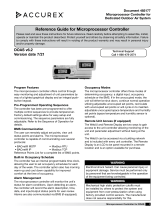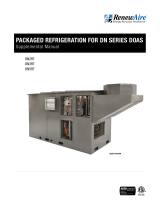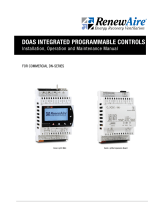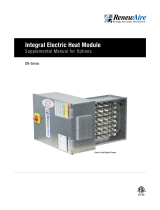Greenheck 484754 Heat-Cool Only Controls for Dedicated Outdoor Air System Operating instructions
- Category
- Split-system air conditioners
- Type
- Operating instructions
Greenheck 484754 Heat-Cool Only Controls for Dedicated Outdoor Air System automates temperature control by integrating with third-party devices. It manages cooling, heating, dehumidification, and economizer functions based on occupancy, temperature, and airflow data. The controller ensures safe operation of refrigeration and heating systems, preventing damage. It's ideal for packaged DX, split DX with remote condensers, or heat pump units, providing precise temperature control and energy efficiency.
Greenheck 484754 Heat-Cool Only Controls for Dedicated Outdoor Air System automates temperature control by integrating with third-party devices. It manages cooling, heating, dehumidification, and economizer functions based on occupancy, temperature, and airflow data. The controller ensures safe operation of refrigeration and heating systems, preventing damage. It's ideal for packaged DX, split DX with remote condensers, or heat pump units, providing precise temperature control and energy efficiency.












-
 1
1
-
 2
2
-
 3
3
-
 4
4
-
 5
5
-
 6
6
-
 7
7
-
 8
8
-
 9
9
-
 10
10
-
 11
11
-
 12
12
Greenheck 484754 Heat-Cool Only Controls for Dedicated Outdoor Air System Operating instructions
- Category
- Split-system air conditioners
- Type
- Operating instructions
Greenheck 484754 Heat-Cool Only Controls for Dedicated Outdoor Air System automates temperature control by integrating with third-party devices. It manages cooling, heating, dehumidification, and economizer functions based on occupancy, temperature, and airflow data. The controller ensures safe operation of refrigeration and heating systems, preventing damage. It's ideal for packaged DX, split DX with remote condensers, or heat pump units, providing precise temperature control and energy efficiency.
Ask a question and I''ll find the answer in the document
Finding information in a document is now easier with AI
Related papers
-
Greenheck Microprocessor Controller Reference guide
-
Greenheck 484715 Microprocessor Controller DOAS v5.0 Operating instructions
-
Greenheck 484279 Microprocessor Controller DOAS v4.001 February 2020 Operating instructions
-
Greenheck AMS & AMD Series with Honeywell Spyder Controller User manual
-
Greenheck 483843 Furnace Controller v1.03 March 2019 Operating instructions
-
Greenheck 481155 Furnace Controller IGF v1.00 Operating instructions
-
Greenheck 482600 AMD-TD Series Packet to the Field Operating instructions
-
Greenheck 482642 Furnace Controller IGF v1.02 Operating instructions
-
Greenheck 479830 Vari-Green Constant Volume Controller for AMS & AMD Series Operating instructions
-
Greenheck 473343 RBD Actuator Kit Operating instructions
Other documents
-
König CS80MMFAN Datasheet
-
König CS60MMFAN Datasheet
-
König CS92MMFAN Datasheet
-
König CS40MMFAN Datasheet
-
 Accurex 485177 Microprocessor Controller User guide
Accurex 485177 Microprocessor Controller User guide
-
 RenewAire DN Series Packaged Refrigeration Supplement Owner's manual
RenewAire DN Series Packaged Refrigeration Supplement Owner's manual
-
 RenewAire DN Series Controls User guide
RenewAire DN Series Controls User guide
-
LG ARND30UDBE4 User manual
-
 RenewAire DN-Series Quick start guide
RenewAire DN-Series Quick start guide
-
 RenewAire DN Series Electric Heater User guide
RenewAire DN Series Electric Heater User guide
















